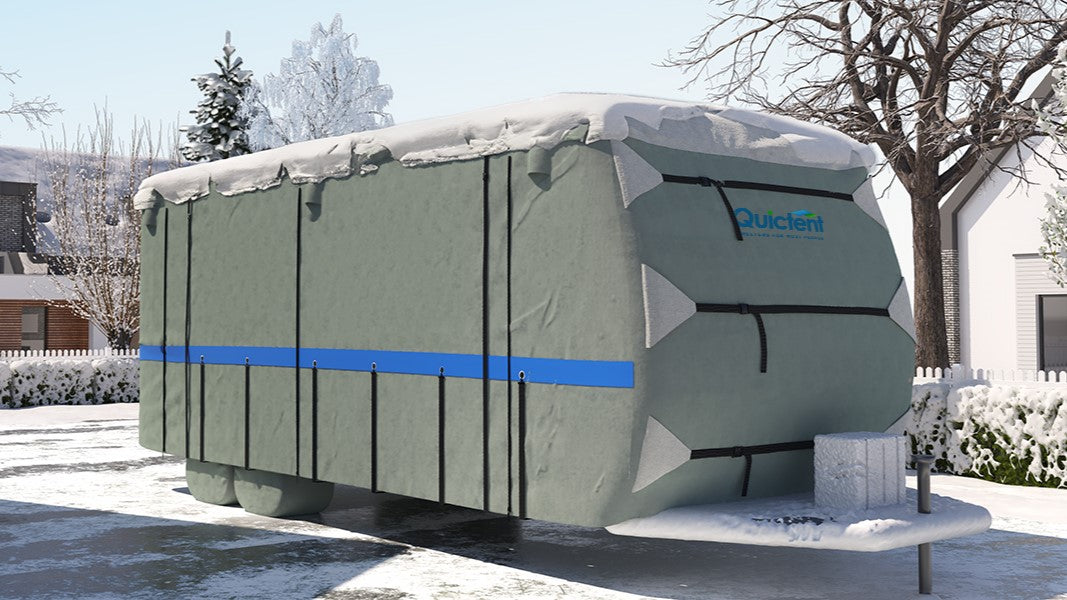Have you ever returned to your RV after a long season, only to find it faded, cracked, or even worse-damaged by mold or mildew? The frustration of finding out what the elements have done to your RV is almost common with every owner. In reality, without proper outdoor protection for an RV, your recreational vehicle is at the mercy of sun, rain, snow, and everything in between. That’s where choosing the right RV cover becomes essential. This article is designed to walk you through the different types of material, for what climates each is best suited, technical considerations, and even maintenance tips so that you can make an informed decision.
Unpacking the Options: RV Cover Fabric Types
The performance heart of any RV cover lies in the material. Each will be different in terms of the level of durability, water resistance, and breathability, which will affect direct protection for your RV.
Polypropylene
Generally the least expensive, lightweight, and provides some RV cover weather resistance. This is normally not very good in a long-term setting and can hardly be applied to intense situations. When exposed to more subtle climates, along with using the van on short terms of intervals, polypropylene material is quite feasible.
Polyester
A step up from polypropylene, polyester strikes a good balance between cost and durability. It proves to be better in terms of RV cover durability and provides better UV-resistant RV covers than its cheaper counterpart. However, for superior water resistance, polyester may require additional treatments, making it a good all-rounder but not perfect.
Olefin
Olefin fabrics have a good balance between strength and breathability. They generally offer better water resistance than polyester, making them a strong contender for those looking for mid-range protection. While slightly more expensive, the improved durability and weather protection can be a worthwhile investment.
Multi-Layered Materials
These provide the utmost protection for RVs, premium RV cover waterproof abilities, and excellent RV cover durability. For different climatic conditions, such materials are manufactured that provide great outdoor RV protection against rain, snow, and UV rays. Generally, the most expensive available; their strength and lifetime can make them well worth the extra cost.

Ultimately, the choice of RV cover fabric types should be based on a combination of your budget and the specific climate challenges in your area.
Matching Your RV Cover to Your Climate
Weather conditions in which you reside or where your RV is parked will make all the difference in choosing the right cover material. Now, let's dive deep into the best options concerning different climates:
Hot and Sunny Climates
In hot and sunny regions, your main concern is to protect your RV from harmful UV rays. You, therefore, need UV-resistant RV covers that will block the sun from fading the paint of your RV and causing its sealant to crack. Moreover, summer RV cover breathability will keep moisture from building up and lower the possibility of mold and mildew inside your cover.
Rainy and Humid Climates
In areas with heavy rain and highly humid areas, the focus should be on waterproof materials. You want one that blocks the moisture totally from reaching, which could cause water damage to the RV. Of essence also is good ventilation in these conditions, to allow for evaporation of any accumulated moisture. Adding a treatment of water repellent keeps the RV cover weather resistance going.
Cold and Snowy Climates
If your area experiences cold temperatures and heavy snowfall, winter RV cover protection is vital. Heavy-duty materials that can withstand the weight of accumulated snow are necessary. Look for fabrics that maintain flexibility in freezing temperatures and won’t become brittle and prone to cracking.
Areas with Variable Weather
You will have to go for multi-layer covers and durable materials offering protection from a wide range of weather types in areas that are very erratic. In such cases, you should look out for a cover that takes care of both UV and rain and additional layers in harsher conditions, offering ideal outdoor RV protection.
Climate-specific RV covers ensure that your RV gets the protection it deserves, whatever the environment may dish out. Such care will extend the life of the RV and make one worry less.
Beyond Material: Key Technical Factors
- Cover Fit: It should be a snug but not overly tight fit. A cover that's too loose will flap in the wind, thereby causing wear and tear. Conversely, a cover that's too tight can stress seams and potentially cause damage.
- Reinforced Seams: Seams are often the weakest point of a cover, so look for reinforced, double-stitched seams to improve durability and prevent water leaks. These are vital for ensuring good RV cover weather resistance.
- Attachment Points: You want to ensure that tie-downs are secure enough not to let the cover fly off during strong winds. That is why multiple attachment points and strong, reinforced straps are inalienable features of every cover.
- Ease of Installation: Consider ease of putting on and taking off since user-friendly designs will substantially ease your life.
Enhancing Your RV Cover's Protective Power
- Access Panels: Find covers with zippered access panels that will allow you to get in your RV and grab something without removing the cover entirely.
- Vents: Appropriately placed vents further allow good ventilation, hence reducing the chances of buildup of moisture or mold and mildew growth. These encourage crucial breathability in summer, even when covered.
- Reinforced Corners: Reinforcement at corners avoids wear and tear, making them strong in high-stress areas.
- Padding: Extra padding on sensitive areas of some covers for added protection against scratches and scuffs.
Keeping Your RV Cover in Top Shape
Even the best RV cover requires regular maintenance to ensure its longevity and continued protection of your RV.
- Regular Cleaning: The dirt, leaves, and other debris that accumulate on the surface should be regularly removed because such materials tend to degrade after some time.
- Inspection: Check your RV cover for tears, rips, or other types of damage. Minor issues, if caught early, can avoid larger problems later.
- Proper Storage: Keep your cover, when not in use, in a place that is both cool and dry. This prevents the building up of mold and mildew.
- Waterproofing Treatments: A water-repellent treatment can be periodically applied to keep the water-resistant qualities of your cover, which would usually be manufactured from polyester among other materials.
With these tips listed herein, you can well maintain your cover to provide excellent service in RV cover durability.
Balancing Protection and Budget
The right RV cover is an important investment, and one would surely think the cost is a consideration. The initial price can vary a great deal depending on material, features, and brand. While the cheapest may be super tempting, one that's more durable, with better RV cover weather resistance, will most likely save you money down the line by preventing costly repairs to your RV. It's always better to invest in a good RV cover with the best protection than having to make repairs or the replacement of parts due to weather damage.
Conclusion
By knowing the different types of RV cover materials, considering your particular climate in choosing climate-specific RV covers, and key technical features, you can be sure your RV will be well-protected against the elements.
With the right RV cover waterproof material, good UV-resistant RV covers, and routine care, a well-chosen cover will do superior outdoor RV protection for the longevity of your investment in an RV.








